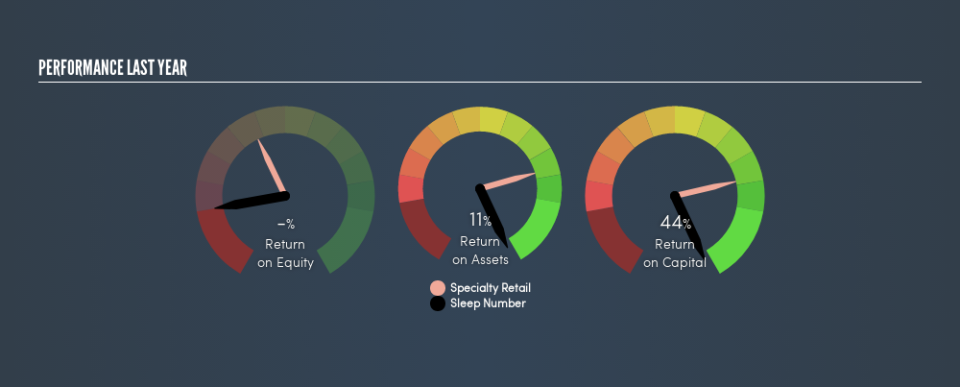Sleep Number Corporation (NASDAQ:SNBR) Is Employing Capital Very Effectively

Today we'll evaluate Sleep Number Corporation (NASDAQ:SNBR) to determine whether it could have potential as an investment idea. Specifically, we'll consider its Return On Capital Employed (ROCE), since that will give us an insight into how efficiently the business can generate profits from the capital it requires.
First up, we'll look at what ROCE is and how we calculate it. Then we'll compare its ROCE to similar companies. Then we'll determine how its current liabilities are affecting its ROCE.
What is Return On Capital Employed (ROCE)?
ROCE is a metric for evaluating how much pre-tax income (in percentage terms) a company earns on the capital invested in its business. Generally speaking a higher ROCE is better. In brief, it is a useful tool, but it is not without drawbacks. Author Edwin Whiting says to be careful when comparing the ROCE of different businesses, since 'No two businesses are exactly alike.'
How Do You Calculate Return On Capital Employed?
Analysts use this formula to calculate return on capital employed:
Return on Capital Employed = Earnings Before Interest and Tax (EBIT) ÷ (Total Assets - Current Liabilities)
Or for Sleep Number:
0.44 = US$98m ÷ (US$771m - US$545m) (Based on the trailing twelve months to March 2019.)
Therefore, Sleep Number has an ROCE of 44%.
See our latest analysis for Sleep Number
Does Sleep Number Have A Good ROCE?
One way to assess ROCE is to compare similar companies. Using our data, we find that Sleep Number's ROCE is meaningfully better than the 14% average in the Specialty Retail industry. I think that's good to see, since it implies the company is better than other companies at making the most of its capital. Putting aside its position relative to its industry for now, in absolute terms, Sleep Number's ROCE is currently very good.
As we can see, Sleep Number currently has an ROCE of 44% compared to its ROCE 3 years ago, which was 21%. This makes us think the business might be improving.
When considering this metric, keep in mind that it is backwards looking, and not necessarily predictive. ROCE can be misleading for companies in cyclical industries, with returns looking impressive during the boom times, but very weak during the busts. This is because ROCE only looks at one year, instead of considering returns across a whole cycle. What happens in the future is pretty important for investors, so we have prepared a free report on analyst forecasts for Sleep Number.
What Are Current Liabilities, And How Do They Affect Sleep Number's ROCE?
Current liabilities include invoices, such as supplier payments, short-term debt, or a tax bill, that need to be paid within 12 months. The ROCE equation subtracts current liabilities from capital employed, so a company with a lot of current liabilities appears to have less capital employed, and a higher ROCE than otherwise. To counter this, investors can check if a company has high current liabilities relative to total assets.
Sleep Number has total assets of US$771m and current liabilities of US$545m. As a result, its current liabilities are equal to approximately 71% of its total assets. While a high level of current liabilities boosts its ROCE, Sleep Number's returns are still very good.
The Bottom Line On Sleep Number's ROCE
So to us, the company is potentially worth investigating further. There might be better investments than Sleep Number out there, but you will have to work hard to find them . These promising businesses with rapidly growing earnings might be right up your alley.
I will like Sleep Number better if I see some big insider buys. While we wait, check out this free list of growing companies with considerable, recent, insider buying.
We aim to bring you long-term focused research analysis driven by fundamental data. Note that our analysis may not factor in the latest price-sensitive company announcements or qualitative material.
If you spot an error that warrants correction, please contact the editor at editorial-team@simplywallst.com. This article by Simply Wall St is general in nature. It does not constitute a recommendation to buy or sell any stock, and does not take account of your objectives, or your financial situation. Simply Wall St has no position in the stocks mentioned. Thank you for reading.

